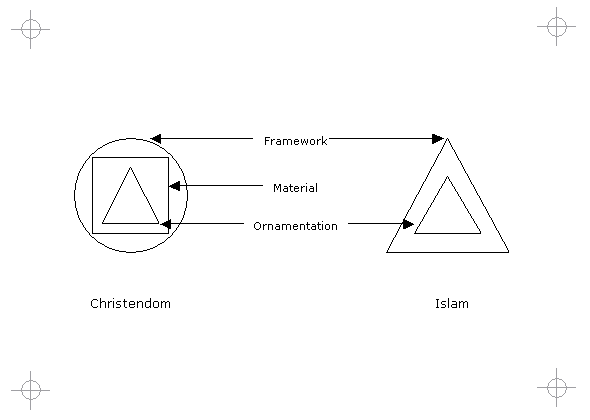|
Diagram
|
|
|

|
|
Title
|
|
|
Framework and Decoration
|
|
Building Architecture
|
|
|
Islamic decoration is based on a framework of writing, vegetal and geometry. This framework provided infinite patterns and variations for decoration. More importantly it enabled adherence to a belief system which forbade any imagery of heaven as a form of idolatry. In Byzantine church architecture, the dome or circle is the framework. Glass was an important enabling material because it provided light to illuminate the inner dome and its visual representation of heaven.
|
|
Architecture Intensive Disciplines
|
|
|
With web based applications it is important to establish a framework for content and components. Frameworks provide not only a visual coherence but also a structure. It enables variations and provides the capability to adopt to change.
|
|
Case Study A: Large Corporate IT
|
|
|

|
|
|
After building a portal framework and linking it to a repository, it was easy to apply changes dynamically by simply configuring the repository. This could only work if all the underlying systems conform to standards. The concept of a framework was to enable "decoration" to be applied - either "organic" such as business logic and function or "inorganic" such as graphical aesthetics.
One interesting aspect of the pattern, is that frameworks are not always obvious - such as those in Islamic decoration. Once you understand it, you look at it in a different light. So to with repository based architectures. Once you realise that the interface is being built dynamically, you begin to appreciate the power behind the approach. Developers were often intrigued that despite the number of screens being created that they were all instances of one server page. The design was not being added as a physical file or source code but as meta data in a database.
|
|
Case Study B: Small Commercial Team
|
|
|

|
|
|
The framework of the application consisted of a user interface design and a component library. The refactory involved creating a component of business data objects (BDO) into which business logic could be programmed. Where possible business logic was encapsulated in either BDO class methods or in database stored procedures. System objects within the framework provide re-use so that over time functionality can be added without having to develop system functions again and again. Initially, the work involved refactoring and no visible progress was made as we were not yet iterating through the project deliverables. Once the framework was in place, we completed each of the new business functionality one after the other in increasingly faster time.
|
|
|


